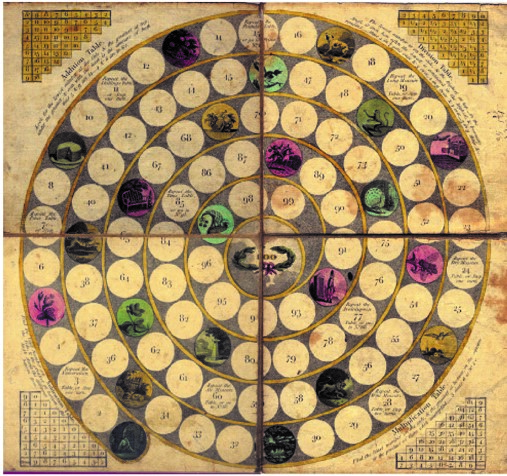By Anne Cartwright

This hand colored, linen-backed game was published in 1798 by John Wallis, London. It is a race game in spiral form designed as an educational tool. As its subtitle explains, it was “intended to infuse the rudiments of arithmetic, under the idea of amusement.”
There are 100 spaces, each having either a number or a picture. Starting at the lower left, one spins the tee-totum(s) with the object of the game being to reach No. 100, the “Laurel Wreath” goal in the center. There are two tee-totums. These are 10-sided spinning tops, the sides numbered 1-10.
“To learn addition” only one tee-totum is used. With each spin you add your new result to your previous position.
For subtraction you spin both, “take the least from the greatest, and move with the remainder.”
In multiplication, you multiply the numbers on the two tee-totums but you only “move with the last figure of their product.”
For division, “Divide the greatest number which come us by the least, observe how many times the latter is contained in the former and how many remain, add these together and move with their sum. Five and eight are contained one and 3 over; 3 and 1 is (4) move there.”
If you land on 1, you end up in “Prison” and lose three turns. If you overshoot 100, you must go back the number of spaces you overshoot.
Some numbered spaces have instructions which require you to recite from memory one of the ten tables (Numeration, Pence, Shillings, Pounds, Long Measure, Dry Measure, Wine Measure, Ale Measure, Avoirdupois, and Time. If you fail, you lose one or more turns, or move back to some previous space or even to Prison. Some spaces send you to a picture space. When players land on a space with a picture–there are 23–they must go to the corresponding numbered instructions (in rhyme) on the outside panels.
The short rhymes give either rewards or punishments. For example, No. 85 requires you to “Repeat the Time’s Table or go to No. 92.” This may at first seem like an advance for not knowing the table, however, No. 92 is a picture space of a soldier standing guard at a sentry box. Landing on No. 92 requires one to stand guard until someone else lands there.
Land on No. 88 and you are rewarded with a double spin; but if you overshoot 100 you must repeat (start over).
The corners of the game board contain the basic addition, subtraction, multiplication, and division tables, and directions for playing. Would or could kids today play this game?
